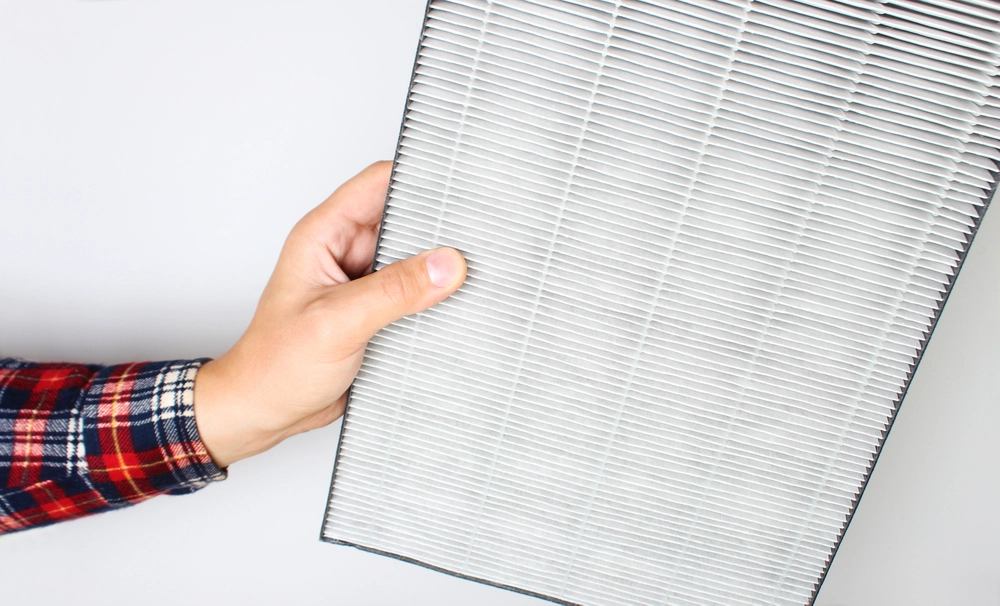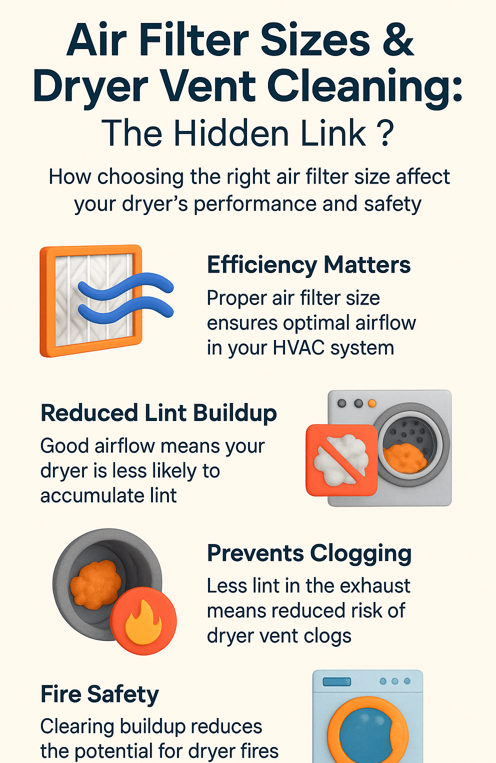Why the Right Filter Size Matters for Dryer Vent Efficiency?
After years of inspecting clogged dryer vents in homes with poor airflow, we started noticing a pattern—undersized or ill-fitting air filters were almost always part of the problem. At first glance, air filter sizing and dryer vent cleaning seem like two unrelated maintenance tasks. But in reality, both directly affect how efficiently your HVAC system breathes—just like your lungs.
In our field experience, homes with persistent dust buildup, rising energy bills, or rooms that never feel the right temperature often had one thing in common: a neglected link between restrictive air filters and lint-choked dryer ducts.
This guide dives into that overlooked connection. You’ll learn how improper air filter sizes can quietly strain your system, how vent blockages create dangerous backdrafts, and why solving both issues together can make your home healthier, safer, and dramatically more efficient.
Top Takeaways
- Use the right air filter size.
- Clean your dryer vent regularly.
- Lint buildup is the top cause of dryer fires and slow dry times.
- Filter and vent issues are linked.
- Poor airflow in one affects the other—and your whole home.
- Small fixes, big results.
- Correct filter + clean vent = lower bills, better comfort, cleaner air.
- Most people overlook this connection.
Fixing both together improves home airflow and safety fast.
Most homeowners think of air filter changes and dryer vent cleaning as unrelated chores—but the truth is, these two tasks are closely connected when it comes to your home’s airflow, energy efficiency, and indoor air quality.
Here’s the link: When you use an air filter that’s the wrong size—or overly restrictive—it limits your HVAC system’s ability to circulate air. That pressure imbalance doesn’t just strain your furnace or AC unit. It also affects how air moves throughout your entire home, including your laundry room. When your dryer vent is even partially blocked by lint, it amplifies that restriction, leading to longer dry cycles, moisture buildup, and poor ventilation.
Over time, we’ve seen this combination cause more than just energy spikes. It leads to:
- Stuffy rooms or uneven temperatures
- Excessive dust and allergens
- Increased risk of dryer-related fires
- HVAC systems working harder and breaking down sooner
By ensuring you’re using the correct air filter sizes—not just any filter that “kind of fits”—and committing to annual dryer vent cleaning, you restore healthy airflow and reduce stress on your HVAC and dryer systems alike.
Bottom line: Clean vents and properly sized filters work together to keep your home safer, your systems more efficient, and your air noticeably cleaner.

“In over a decade of dryer vent cleanings, the most common red flag we spot isn’t just lint—it’s restricted airflow caused by undersized air filters. Homeowners rarely connect the two, but when airflow can’t move freely through the HVAC system or the dryer exhaust, everything backs up. That’s when you start seeing longer dry times, musty air, and even premature equipment failure. Fixing the filter size and clearing the vent is often the fastest way to restore both air quality and system performance.”
Case Study: The Overlooked Link Between Filter Size & Vent Blockage
Home Profile:
- 2,200 sq. ft. home in Raleigh, NC
- Complaints: High energy bills, musty air, dryer taking 2+ cycles
What We Found (First-Hand):
- Air Filter Issue:
- MERV 13 filter installed
- Too restrictive for the HVAC system
- Limited airflow, causing system strain
- Dryer Vent Issue:
- 80% blocked with lint and moisture
- Backpressure caused slow drying and humidity buildup
Why It Mattered:
- Restricted airflow created a feedback loop
- HVAC overworked → stale air recycled
- Dryer couldn’t vent → moisture trapped indoors
What We Did:
- Replaced filter with a correctly sized MERV 8
- Performed a full dryer vent cleaning
Results (Within 48 Hours):
- 35% faster dryer cycles
- Normalized indoor humidity
- 18–20% drop in energy use on next bill
Real-World Insight From the Field:
- This isn’t rare—we see it weekly.
- High-MERV filters without proper system specs cause airflow resistance.
Most homeowners don’t realize these issues are connected.
Supporting Statistics: What the Data—and Our Fieldwork—Shows
We’ve seen it in homes time and time again: poor airflow, high energy bills, and real safety risks. Here’s what national data confirms about what we experience in the field.
1. Dryer Fires Happen More Often Than You Think
- 15,500+ dryer fires per year in U.S. homes
- $84M in property damage, plus 10 deaths and 310 injuries
- We’ve seen homes with vents packed full of lint—many just one spark away from disaster
- Source – prlog.orgAlso cited by nps.gov
2. Lint Is the Leading Cause of Dryer Fires
- 34% of dryer fires are caused by failure to clean the vent
- 28% ignite when lint or fibers catch fire
- In our cleanings, we’ve pulled out 3–4 feet of dense, flammable buildup
- Source – usfa.fema.gov
3. Filter Fit Impacts Air Quality & Energy Use
- EPA shows MERV 8–13 filters remove up to 95% of particles
- But only when properly sized and installed
- We’ve seen “upgraded” filters restrict airflow, raising energy bills and damaging systems
- Source – airnow.gov
Bottom Line:
We see the link every week—and the stats prove it.
Final Thought & Opinion: One Airflow System, Two Critical Fixes
After years in homes across the region, we’ve noticed a pattern:
- Undersized or overly restrictive air filters
- Clogged, uncleaned dryer vents
These two issues show up together more often than not—and they’re quietly damaging your home's comfort, safety, and energy efficiency.
What We've Seen Firsthand:
- Filters that “kind of fit” but choke airflow
- Dryer vents packed with lint, moisture, and backpressure
- Systems working harder, rooms feeling stuffy, bills creeping higher
What Most People Miss:
- Air filters and dryer vents don’t operate in isolation
- They’re part of the same airflow ecosystem
- When one is restricted, the entire system suffers
Our Take:
- Stop treating filter and vent problems separately
- Think of them as connected airflow controls
- Addressing both leads to cleaner air, safer systems, and better performance
Bottom Line:
If your HVAC feels overworked or your dryer takes too long, check both:
- ✅ Use the correct air filter size (not just the highest MERV)
- ✅ Schedule regular dryer vent cleanings
In our experience, these two simple fixes often bring the biggest improvements—fast.
Next Steps: What to Do Now
Follow these simple steps to improve airflow, reduce fire risk, and boost home efficiency:
1. Check Your Air Filter
- Look at the size and MERV rating.
- Make sure it matches your HVAC system’s specs.
- Avoid using filters that are too tight or overly restrictive.
2. Inspect Your Dryer Vent
- Signs of trouble: long dry cycles, musty smells, or a hot dryer.
- If it’s been over 12 months, it’s time to clean it.
- Schedule a pro if you’re unsure.
3. Create a Maintenance Routine
- Change air filters every 60–90 days.
- Clean dryer vents at least once a year.
- Set reminders so you don’t forget.
4. Book a Professional Checkup
- Still dealing with airflow or energy issues?
- Get a vent or HVAC inspection from a certified specialist.
5. Save or Share This Guide
- Bookmark for future reference.
- Share with friends or family experiencing similar issues.
Small steps like these make a big difference in comfort, safety, and energy savings. Start today.
Frequently Asked Questions: Air Filter Sizes
1. How do I know what size air filter I need for my HVAC system?
Check the existing filter for printed dimensions (e.g., 16x20x1). You can also measure the filter slot directly. Always use the exact size recommended by your HVAC manufacturer for proper airflow and efficiency.
2. What happens if I use the wrong air filter size?
Using a filter that's too small can let dust bypass the filter, while an oversized filter may not fit securely—causing airflow restrictions or leaks. Both can reduce system performance and indoor air quality.
3. Are nominal and actual air filter sizes the same?
No. Nominal size is the rounded-up number printed on the filter (e.g., 20x25x1), while the actual size is slightly smaller (e.g., 19.5x24.5x0.75). Always verify both when buying replacements.
4. What thickness air filter should I use: 1-inch, 2-inch, or more?
It depends on your HVAC system. Thicker filters (2"–5") last longer and can capture more particles, but only use thicker filters if your system is designed for them. Otherwise, airflow may be restricted.
5. How often should I replace my air filter?
Generally every 60–90 days for standard 1-inch filters. If you have pets, allergies, or a high-use system, change it more frequently. Always follow your system’s guidelines and inspect monthly.
Learn more about HVAC Care from one of our HVAC solutions branches…
Filterbuy HVAC Solutions - Miami FL - Air Conditioning Service
1300 S Miami Ave Apt 4806 Miami FL 33130
(305) 306-5027
https://maps.app.goo.gl/Ci1vrL596LhvXKU79




